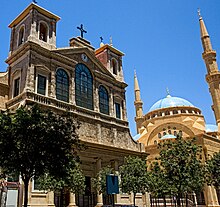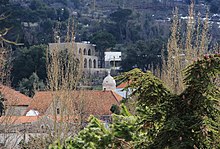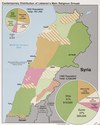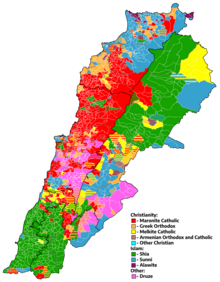
This is a demography of the population of Lebanon including population density, education level, health of the populace, economic status, religious affiliations and other aspects of the population.
Sectarianism is a debated concept. Some scholars and journalists define it as pre-existing fixed communal categories in society, and use it to explain political, cultural, or religious conflicts between groups. Others conceive of sectarianism as a set of social practices where daily life is organised on the basis of communal norms and rules that individuals strategically use and transcend. This definition highlights the co-constitutive aspect of sectarianism and people’s agency, as opposed to understanding sectarianism as being fixed and incompatible communal boundaries.
The National Pact is an unwritten agreement that laid the foundation of Lebanon as a multiconfessional state following negotiations between the Shia, Sunni, and Maronite leaderships. Erected in the summer of 1943, the National Pact was formed by the then-president Bechara El Khoury and the prime minister Riad Al Solh. Mainly centered around the interests of political elites, the Maronite elite served as a voice for the Christian population of Lebanon while the Sunni elite represented the voice of the Muslim population. The pact also established Lebanon's independence from France.

The Catholic Church in Lebanon is part of the worldwide Catholic Church under the spiritual leadership of the Pope in Rome.

Christianity in Lebanon has a long and continuous history. Biblical Scriptures show that Peter and Paul evangelized the Phoenicians, whom they affiliated to the ancient Patriarchate of Antioch. Christianity spread slowly in Lebanon due to pagans who resisted conversion, but it ultimately spread throughout the country. Even after centuries of Muslim rule, it remains the dominant faith of the Mount Lebanon region and has substantial communities elsewhere.
Islam is the official religion in Kuwait, and the majority of the citizen population is Muslim.
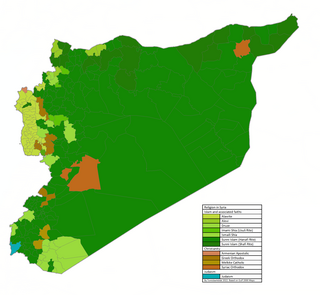
Religion in Syria refers to the range of religions practiced by the citizens of Syria. Historically, the region has been a mosaic of diverse faiths with a range of different sects within each of these religious communities.
According to Article 9 of the Lebanese Constitution, all religions and creeds are to be protected and the exercise of freedom of religion is to be guaranteed providing that the public order is not disturbed. The Constitution declares equality of rights and duties for all citizens without discrimination or preference. Nevertheless, power is distributed among different religious and sectarian groups. The position of president is reserved for a Maronite Christian; the role of Presidency of Parliament for a Shiite Muslim; and the role of Prime Minister for a Sunni Muslim. The government has generally respected these rights; however, the National Pact agreement in 1943 restricted the constitutional provision for apportioning political offices according to religious affiliation. There have been periodic reports of tension between religious groups, attributable to competition for political power, and citizens continue to struggle with the legacy of the civil war that was fought along sectarian lines. Despite sectarian tensions caused by the competition for political power, the Lebanese continue to coexist.
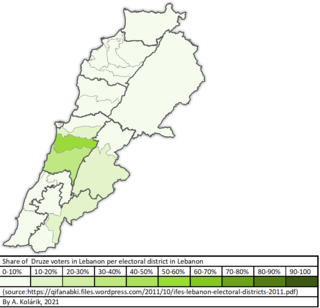
The Lebanese Druze are an ethnoreligious group constituting about 5.2 percent of the population of Lebanon. They follow the Druze faith, which is an esoteric Abrahamic religion originating from the Near East, and self identify as unitarians.
Sectarianism can be defined as a practice that is created over a period of time through consistent social, cultural and political habits leading to the formation of group solidarity that is dependent upon practices of inclusion and exclusion. Sectarian discrimination focuses on the exclusion aspect of sectarianism and can be defined as 'hatred arising from attaching importance to perceived differences between subdivisions within a group', for example the different denominations of a religion or the factions of a political belief.

Beirut III was an electoral district in Lebanon. It covered six neighbourhoods (quartiers) in the western parts of the capital; Dar El Mreisse, Mazraa, Minet El Hosn, Moussaitbeh, Ras Beirut and Zuqaq al-Blat. The constituency elected ten members of the Parliament of Lebanon; five Sunni Muslim, one Shia Muslim, one Druze, one Protestant, one Greek Orthodox and one Minorities. The constituency was created with the 2008 Doha Agreement, ahead of the 2009 parliamentary election.
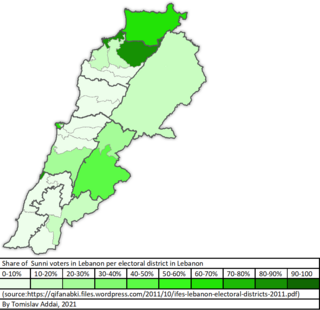
Lebanese Sunni Muslims refers to Lebanese people who are adherents of the Sunni branch of Islam in Lebanon, which is one of the largest denomination in Lebanon tied with Shias. Sunni Islam in Lebanon has a history of more than a millennium. According to a CIA 2018 study, Lebanese Sunni Muslims constitute an estimated 30.6% of Lebanon's population.

Islam in Lebanon has a long and continuous history. According to an estimate by the CIA, it is followed by 63% of the country's total population. Sunnis make up 31.9%, Twelver Shia make up 31.2%, next to smaller percentages of other Shia branches, such as Alawites and Ismailis. The Druze community is designated as one of the five Lebanese Muslim communities, even though most Druze do not identify as Muslims, and they do not accept the five pillars of Islam.
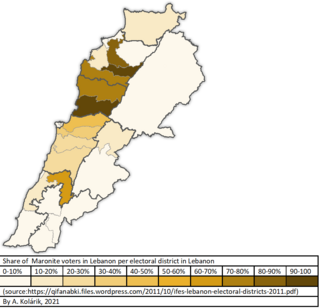
Lebanese Maronite Christians refers to Lebanese people who are members of the Maronite Church in Lebanon, the largest Christian denomination in the country. The Lebanese Maronite population is concentrated mainly in Mount Lebanon and East Beirut. They are believed to constitute about 30% of the total population of Lebanon.

Irreligion is very uncommon in Lebanon, as Islam and Christianity are the predominant faiths. It is difficult to quantify the number of atheists or agnostics in Lebanon as they are not officially counted in the census of the country. The Lebanese Constitution guarantees the freedom of belief. There is a great stigma attached to being an atheist in Lebanon, thus many Lebanese atheists communicate via the internet. It is difficult not to have your religion stated at birth, although a baby made history in doing so in 2014.
Lebanese Protestant Christians refers to Lebanese people who are adherents of Protestantism in Lebanon.

Lebanese Melkite Christians refers to Lebanese people who are members of the Melkite Greek Catholic Church in Lebanon, which is the third largest Christian group in the country after the Maronite Church and the Greek Orthodox Church of Antioch.
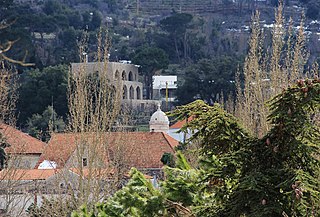
Christianity and Druze are Abrahamic religions that share a historical traditional connection with some major theological differences. The two faiths share a common place of origin in the Middle East, and are monotheistic. Christian and Druze communities share a long history of interaction dating back roughly a millennium, particularly in Mount Lebanon. Over the centuries, they have interacted and lived together peacefully, with occasional exceptions. Moreover, Druze beliefs, scriptures and teachings incorporate several elements from Christianity.
The Kisrawan campaigns were a series of Mamluk military expeditions against the mountaineers of the Kisrawan, as well as the neighboring areas of Byblos and the Jurd, in Mount Lebanon. The offensives were launched in 1292, 1300 and 1305. The mountaineers were Shia Muslim, Alawite, Maronite and Druze tribesmen who historically acted autonomously of any central authority. The Maronites in particular had maintained close cooperation with the last Crusader state, the County of Tripoli. After the fall of Tripoli to the Mamluks in 1289, the mountaineers would often block the coastal road between Tripoli and Beirut, prompting the first Mamluk expedition in 1292 under the viceroy of Egypt, Baydara. During that campaign, the Mamluks, spread along the coastal road and cut off from each other at various points, were constantly harried by the mountaineers, who confiscated their weapons, horses and money. Baydara withdrew his men only after paying off the mountain chiefs.
Sectarianism in Lebanon refers to the formal and informal organization of Lebanese politics and society along religious lines. It has been formalized and legalized within state and non-state institutions and is inscribed in its constitution. Lebanon recognizes 18 different sects: 67.6% of the population is Muslim, 32.4% is Christian, the majority being Maronites Catholics and Greek Orthodox, while 4.52% is Druze. The foundations of sectarianism in Lebanon date back to the mid-19th century during Ottoman rule. It was subsequently reinforced with the creation of the Republic of Lebanon in 1920 and its 1926 constitution, and in the National Pact of 1943. In 1990, with the Taif Agreement, the constitution was revised but did not structurally change aspects relating to political sectarianism. The dynamic nature of sectarianism in Lebanon has prompted some historians and authors to refer to it as "the sectarian state par excellence" because it is a mixture of religious communities and their myriad sub-divisions, with a constitutional and political order to match.
